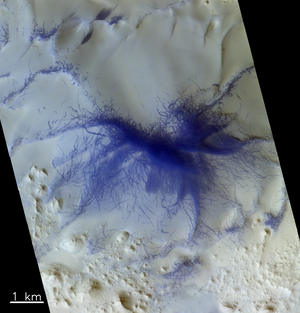

Mars dust devils in action
Giant dust devils – swirling columns of wind – are constantly scouring the surface of Mars.
In this pair of images, captured 27 February 2019 by the CaSSIS camera on the ESA-Roscosmos ExoMars Trace Gas Orbiter about 45 seconds apart, two dust devils have been caught in action. The bright ‘plumes’ were seen travelling across the inside of a 70 km crater in the southern hemisphere of Mars, leaving a dark streak behind them. The shadows of the two dust columns can also be seen in motion. The dust devil in the left part of the image is travelling at about 4 m/s, while the one on the right is travelling at 8 m/s.
The dark patch of ground in the left of the image is a large basaltic dune field.
Frequent dust devil action leaves this typical web of crisscrossing marks in the surface as they lift the top layer of dust away, leaving darker paths in their wake.
Dust devils on Mars form in much the same way as those on Earth: when the ground gets hotter than the air above it, rising plumes of hot air move through cooler denser air, creating an updraft, with the cooler air sinking and setting up a vertical circulation. If a horizontal gust of wind blows through, the dust devil is triggered. Once whirling fast enough, the spinning funnels can pick up dust and push it around the surface.
Martian dust devils are much larger than their Earth counterparts, though. On the Red Planet they can tower up to eight kilometres high, creating paths that are tens to hundreds of metres wide, stretching out for several kilometres. Their colossal size makes them highly effective at carrying dust high up into Mars’ atmosphere. As such, they are interesting – and important – to study in order to understand how they might influence the planet’s climate over time.
One of the scientific goals of the CaSSIS imager is to investigate dynamic surface processes, including aeolian processes like these, and to support the orbiter's suite of spectrometers in documenting trace gases in the planet's atmosphere and their potential sources.





